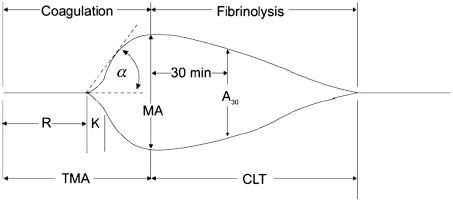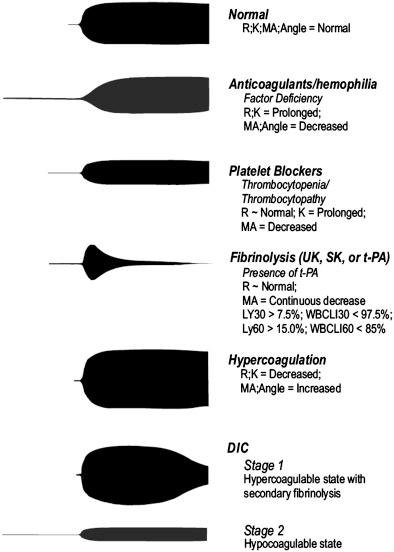Physical Address
304 North Cardinal St.
Dorchester Center, MA 02124
Recent years have seen a significant increase in the utilization of rotational viscoelectric global hemostasis testing in point-of-care settings in support of complicated surgical procedures and trauma. The current instruments allow near real-time data gathering, with many results being available between 10 and 30 minutes post blood draw. The tests are sensitive to large alterations of clotting factors, inhibitors, fibrinogen, platelets, and fibrinolytic cascade. The short time to results and the sensitivity to multiple components of the hemostasis system make such testing particularly attractive for guiding transfusion protocols and pharmacologic therapy. Recent advances in digital instrumentation and options for testing have simplified the simultaneous assessment of multiple components of hemostasis and have somewhat reduced the interpretative challenges associated with the testing. The predictive power of the test results as applied to hemorrhage or thrombosis in nonacute settings has not yet been firmly established.
Recent years have seen a significant increase in the utilization of rotational viscoelectric global hemostasis testing in point-of-care settings in support of complicated surgical procedures and trauma. The current instruments allow near real-time data gathering with many results available between 10 and 30 minutes post blood draw. The tests are sensitive to large alterations in clotting factors, inhibitors, fibrinogen, platelets, and fibrinolytic cascade. The short time to results and sensitivity to multiple components of the hemostasis system make such testing particularly attractive to guide transfusion protocols and pharmacologic therapy. The methodology itself is not new, having been pioneered by Hartert in 1948, but until recently it had limited applicability, mainly in the settings of cardiopulmonary bypass and liver transplantation. Recent advances in digital instrumentation and options for testing have simplified the simultaneous assessment of multiple components of hemostasis and somewhat reduced the interpretative challenges associated with the testing. These improvements have gained the technique wider acceptance in trauma resuscitation and additional surgical interventions. Less clear is the applicability of the test results in nonacute settings. The predictive power of the test results as applied to hemorrhage or thrombosis in nonacute settings has not yet been firmly established.
Two systems are currently on the market: TEG 5000/TEG 6S (Haemonetics, Braintree, MA, US) and ROTEM delta (TEM Systems, Durham, NC, US). The TEG system refers to the test modality as thromboelastography, whereas ROTEM terms it thromboelastometry. Conceptually the tests are quite similar, but do differ in implementation, nomenclature of the output, and options. Both tests measure torque applied to a pin by a whole-blood or plasma sample in a cup heated to 37°C during oscillating rotation through a 4 degrees 45′ angle. The torque is minimal in an unclotted sample but increases with the formation of the clot because of clot-mediated bridge formation between the pin and the walls of the cup and increased sample viscosity. TEG utilizes a rotating cup and stationary pin connected to a torsion wire. As a clot forms, the torque due to rotation of the cup is increasingly transmitted to the pin. ROTEM has a rotating pin in a stationary cup. Clot formation impedes pin rotation. An optical detector is used to monitor the position of the pin. Output of both instruments is presented graphically and numerically in nearly real time. An illustration of the graphical output is provided in Fig. 139.1 .

Generally TEG and ROTEM use citrated recalcified whole blood. Classic thromboelastography used whole blood and no activators of clotting. This option is still available on both the TEG 5000 and ROTEM systems but because of very large variability in procedures and lack of standardization this option is not recommended for clinical use. Combinations of activators and hemostasis component inhibitors have been developed to allow assessment of parts of the hemostatic system in isolation. A summary of testing options available on ROTEM and TEG systems is provided in Tables 139.1 and 139.2 , respectively. TEG 6s is a new point-of-care device that integrates all combinations of activators into cartridges named “global hemostasis” and platelet mapping.
| Reagent | Activators and Inhibitors | Application Notes |
|---|---|---|
| Natem | No activator | Mainly used in research, very sensitive to hemostasis abnormalities, but slow and nonspecific. Varying contact and platelet activation during blood draw can influence results. |
| Intem | PTT-type contact activator composed of phospholipid made of rabbit brain, ellagic acid | Sensitive to low dose (0.2–1.0 U) unfractionated heparin, rapid coagulation activation with CT reached in 100–240 seconds. |
| Extem | PT-type activator recombinant tissue factor and phospholipids, heparin inhibitor | Not sensitive up to 5 U of heparin. CT becomes prolonged at INR >3.5 in vitamin K deficiency. |
| Heptem | Intem reagent + heparinase | In comparison with Intem, measured the effect of heparin reversal able to detect coagulation disorders in the presence of heparin. |
| Fibtem | Extem reagent + cytochalasin D | Cytochalasin D inhibits platelets. Clot is composed mainly of fibrin. Allows assessment of functional fibrinogen and in platelet contribution in comparison with Extem. |
| Aptem | Extem reagent + aprotinin | Aprotinin inhibits plasmin allowing to confirm plasmin-dependent clot degradation in comparison to Extem. Can also be used to monitor antifibrinolytic therapy. |
| ROTEM platelet (effect of aspirin, clopidogrel or GP IIb/IIIa antagonists) on platelet aggregation | Adp-tem uses ADP to induce platelet aggregation and detection of ADP receptor inhibitors (clopidrogel) | Platelet aggregation is measured by impedance for 6 minutes and 3 parameters are reported: AUC (area under the curve, Ohm∗min); A6 (amplitude at 6 minutes in Ohm); MS (maximum slope of the aggregation graph in Ohm/minute). |
| Ara-tem uses arachidonic acid to induced platelet aggregation and detection of cycloxygenase inhibitors (aspirin) | ||
| TRAP-tem uses thrombin analogue to detect GP IIb/IIIa inhibitors (abciximab) |
| Reagent | Activators and Inhibitors | Application Notes |
|---|---|---|
| TEG native | No activator | Mainly for research use, similar to Natem. |
| Not available in TEG 6S | ||
| TEG kaolin | PTT-like activation Kaolin + phospholipid | Similar to item, but uses slower activation with kaolin rather then ellagic acid, may be sensitive to lupus anticoagulant. |
| Included in “global hemostasis” for TEG 6S | ||
| TEG rapid | PT-like clot activation with tissue factor and phospholipid | Fast results, but less sensitive to factor deficiencies and platelet function disorders. |
| Included in “global hemostasis” for TEG 6S | ||
| TEG heparin with heparinase | TEG kaolin + heparinase | In combination with TEG, kaolin allows monitoring of heparin reversal and allows detection of coagulation disorders in the presence of heparin. |
| Included in “global hemostasis” for TEG 6S | ||
| TEG functional fibrinogen | Reptilase + FXIII + heparin (reagent K) | The reagent does not significantly activate platelets due to thrombin inhibition by heparin. Thus allows isolating fibrinogen contribution to clot strength. |
| Included in “global hemostasis” for TEG 6S | ||
| TEG global hemostasis | This cartridge includes TEG kaolin, TEG rapid, TEG with heparinase cup, and TEG functional fibrinogen | Available in TEG 6S instruments. It does not provide % lysis (LY30, LY60). |
| TEG platelet mapping (effect of aspirin and/or clopidogrel) on platelet activation | For aspirin: reagent K (RK)+arachidonic acid | In comparison to reagent K activation alone and TEG kaolin allows calculation of percent platelet aggregation as follows (MA ADP(AA) − MA RK )/(MA Kaolin − MA RK ) × 100 |
| For clopidogrel: reagent K + ADP |
Commonly reported parameters that are measured in TEG and ROTEM are summarized in Table 139.3 and illustrated in Fig. 139.1 . Additional calculated parameters are available on both the TEG and ROTEM instruments. The TEG coagulation index (CI) parameter, for instance, attempts to capture an overall status of the hemostatic system in a single number based on combination of r, k, MA, and α. The parameter is used in either native or celite-activated whole blood and aims to discriminate between hypocoagulable CI < −3 and hypercoagulable CI > 3 patients. The validity of this and other calculated parameters for predicting either hemorrhage or thrombosis is yet to be clearly established.
| Instrumentation | TEG | ROTEM | |
|---|---|---|---|
| Clot time (period to 2 mm amplitude) | r | CT | Similar to PT/PTT, measures time between sample activation and clot initiation, prolonged in heparin treatment, clotting factor deficiencies and severe thrombocytopenia (lack of surface substrate) |
| Period from 2 to 20 mm amplitude | k | CFT | Time of clot propagation depends on thrombin activity, fibrinogen, platelet function, and number |
| Alpha angle | α (tangent between r and k) | α (angle at r) | Velocity of clot propagation depends on similar factors as k with large fibrinogen contribution |
| Maximal angle | – | CFR | Maximal velocity of clot propagation |
| Maximum strength of the clot | MA | MCF | Maximal amplitude achieved through formation of the clot, primarily due to platelet number and function with contribution from fibrinogen and thrombin activity |
| Amplitude at a set time | A (A30, A60) | same | Allows measure of residual clot strength at a given time and allows assessment of fibrinolysis |
| Percent clot remaining at a set time | CL (CL30, 60) | LI30, LI60 | Calculated as (A(t)/MA)∗100 |
| Rate of clot lysis | LY (LY30, LY60) | – | Calculated as % reduction of the area under the curve in the amplitude trace, representation of total fibrinolytic activity |
| Shear-elastic modulus strength | G | MCE | Calculated by converting A to measure of shear. TEG calculation is 5∗A/(100−A), reported in Kdynes/cm 2 |
Often additional information can be gained from analyzing the shape of the output curves. The typical TEG findings in a range of disorders of hemostasis are illustrated in Fig. 139.2 . Similar findings are expected with ROTEM traces.

Although reference ranges based on multiinstitutional clinical trials have been published for both ROTEM and TEG instruments, recent proficiency data indicate very large interinstitutional variation in results, with coefficients of variation of up to 80%. Thus generic reference ranges may not be applicable to individual centers and should be locally evaluated. Many parameters show age-related changes, likely due to increasing concentrations of fibrinogen with age.
Many institutions have developed procedure-specific transfusion protocols that use the test results as guidance for specific product replacement and/or pharmacologic therapy. Thus prolonged r (CT) without evidence of heparin interference is used to trigger plasma transfusion, low fibrinogen value for cryoprecipitate, and low MA (MCF) for platelet transfusion. In addition, if overheparinization is noted (unexpected prolonged r [CT] value corrected on heparin removal) protamine may be used. Primary fibrinolysis as evidenced by prolonged or normal r (CT) with low clot strength and early clot lysis triggers consideration for antifibrinolytic therapy, whereas secondary (compensatory) fibrinolysis in a hypercoagulable patient (short r [CT] and high MA [MCF]) usually does not. Clearly, clinical considerations often take priority over reported test values in therapy considerations. Values for transfusion and intervention triggers vary significantly with specific clinical situation (e.g., trauma vs. liver transplant) and institution. Overall, TEG- and ROTEM-guided transfusion protocol usage in massive transfusion settings has resulted in a decrease in blood product utilization and blood loss but has not yet been proven to decrease donor exposure or improve long-term morbidity or mortality. The field is rapidly evolving.
Become a Clinical Tree membership for Full access and enjoy Unlimited articles
If you are a member. Log in here